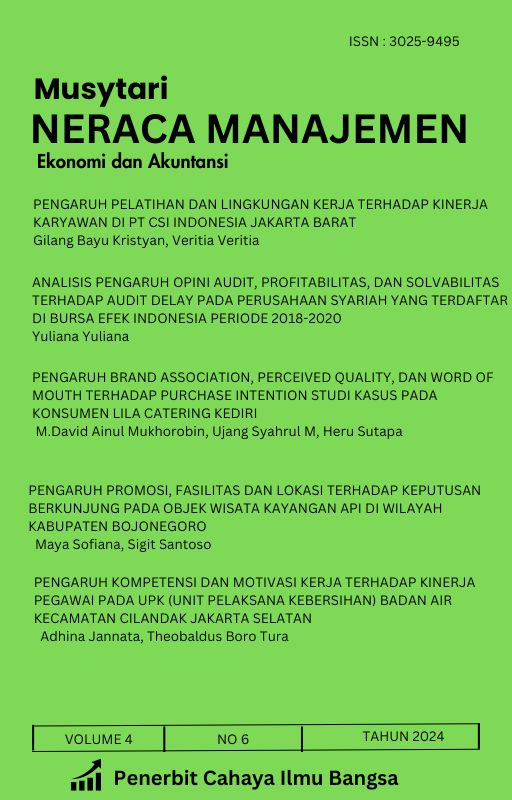INTENSITAS ASET TETAP, LEVEREGE, INVENTORY INTENSITY DAN PENGARUH TERHADAP PENGHINDARAN PAJAK (Studi Empiris Pada Perusahaan Non-Cyclical Yang Terdaftar di Bursa Efek Indonesia (BEI) Tahun 2020-2023)
Main Article Content
Abstract
This study aims to examine the effects of the effect of fixed assets, leverege and inventory intensity on tax avoidance. This research is associative quantitives with secondary data used in this study originating from financial statements and company annual reports Non cylical registered on the official website of the Indonesia Stock Exchange and the official website of the non cylical company in 2020-2023. There are 9 company data used as samples obtained through purposive sampling. The analytical method used is multiple linear regression analysis with the help of the EViews 12 program. The results of this study indicate that the intensity of fixed assets, leverege and inventory intensity together influence tax avoidance, the intensity of assets remains influencing tax avoidance, Leverege does not affect tax avoidance, and Inventory Intensity does not affect tax avoidance.
Downloads
Article Details

This work is licensed under a Creative Commons Attribution-NonCommercial 4.0 International License.
This work is licensed under a Creative Commons Attribution-ShareAlike 4.0 International License.
References
Anggriantari, C. D., & Purwantini, A. H. (2020, November). Pengaruh Profitabilitas, Capital Intensity, Inventory Intensity, dan Leverage Pada Penghindaran Pajak. In UMMagelang Conference Series (pp. 137-153).
Anindyka, D., Pratomo, D., & Kurnia, K. (2018). Pengaruh Leverage (Dar), Capital Intensity Dan Inventory Intensity Terhadap Tax Avoidance (Studi Pada Perusahaan Makanan Dan Minuan Di Bursa Efek Indonesia (Bei) Tahun 2011-2015). eProceedings of Management, 5(1).
Basuki, A. T., & Yuliadi, I. (2014). Elektronik Data Prosesing (SPSS 15 dan EVIEWS 7). Danisa Media.
Bamulki, M., & Nugraeni, N. (2023). Pengaruh Sales Growth, Kepemilikan Keluarga, Profitabilitas, dan Leverage terhadap Penghindaran Pajak pada Perusahaan Pertambangan Periode 2020-2022. Jurnal Pendidikan Tambusai, 7(3), 27880-27885.
Dewi, N. L. P. P., & Noviari, N. (2016). Pengaruh ukuran perusahaan, leverage, profitabilitas dan corporate social responsibility terhadap penghindaran pajak (tax avoidance). Sumber, 1(166), 20.
Napitupulu, R. B., Simanjuntak, T. P., Hutabarat, L., Damanik, H., Harianja, H., Sirait, R. T. M., & Tobing, C. E. R. L. (2021). Penelitian Bisnis, Teknik dan Analisa dengan SPSS-STATA-Eviews. Madenatera.
Napitupulu, R. B., Simanjuntak, T. P., Hutabarat, L., Damanik, H., Harianja, H., Sirait, R. T. M., & Tobing, C. E. R. L. (2021). Penelitian Bisnis, Teknik dan Analisa dengan SPSS-STATA-Eviews. Madenatera.
Noviyani, E., & Mu'id, D. (2019). Pengaruh return on assets, leverage, ukuran perusahaan, intensitas aset tetap dan kepemilikan institusional terhadap penghindaran pajak. Diponegoro Journal of Accounting, 8(3).
Prihatini, C., & Amin, M. N. (2022). Pengaruh Profitabilitas, Leverage, Ukuran Perusahaan, Intensitas Aset Tetap Dan Kualitas Audit Terhadap Tax Avoidance. Jurnal Ekonomi Trisakti, 2(2), 1505-1516.
Putri, L. C. E., & Pratiwi, A. P. (2022). Pengaruh intensitas modal, inventory intensity dan transfer pricing terhadap tax avoidance. Jurnal Ilmiah Mahasiswa Ekonomi Akuntansi (JIMEKA), 7(4), 555-563.
Ratnasari, D., & Nuswantara, D. A. (2020). Pengaruh kepemilikan institusional dan leverage terhadap penghindaran pajak (tax avoidance). Jurnal Akuntansi AKUNESA, 9(1).
Ulfa, R. (2021). Variabel penelitian dalam penelitian pendidikan. Al-Fathonah, 1(1), 342-351.

